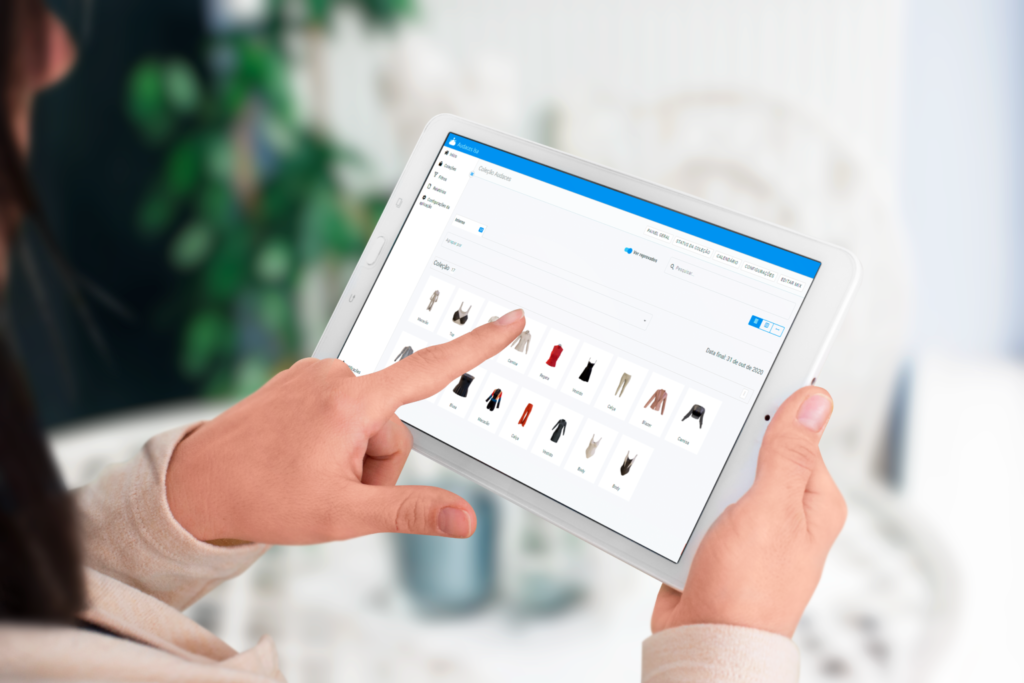Summary
- Planning the next releases of your fashion company involves several steps.
- Effective collection management during this process can determine its success or failure.
- You can always use technology to ease your work. Start today with Audaces360 free trial!
To increase the chances of meeting market demands and achieving sales success for your fashion releases, it is essential to prioritize effective collection management.
Planning and organization should take place before the creative process even begins, requiring different types of research to guide the creation of designs.
This allows for the saving of time and resources, leading to a more assertive collection and avoiding errors and delays.
We have gathered some tips to ease this process. Take a look!
Sumário
Why automate your collection management?
Choosing online collection management can significantly boost your efficiency and shorten product launch time.
Technology helps to automate repetitive processes, centralize all your collection data in one accessible location, and reduce manual tasks and spreadsheets.
Having a clear overview of your collections allows for analyzing past collections, identifying pinpoint areas for improvement, and avoiding repeat mistakes.
Additionally, online tools can provide clear, concise instructions to your development team. This eliminates confusion and guarantees everyone is on the same page, fostering better collaboration and reducing errors.
By increasing transparency and visibility of the collection processes, you can focus on the big picture that online management offers to have a better comprehension of the final customer experience.
This ensures that your company will release the best possible product at a competitive price, enhancing satisfaction, and maximizing your chances of sales and solidifying customer loyalty.
Learn more: 7 steps to develop your fashion collection plan

What is collection management life cycle?
Collection management life cycle incorporates all the processes that transform an initial concept into a complete and marketable product mix.
After the initial research to understand your target audience’s desire, designers create mood boards with references that will define the essence of the collection – including aesthetics, colors, and textures of the new products.
From there, the more technical stages of the fashion collection production begin.
Each stage is defined by the set of actions and professionals involved to guide each product through its correct development cycle.
Precise workflows and clear timelines are crucial, fostering seamless collaboration between design, production, and marketing departments.
This synchronized approach minimizes delays and reworks, bringing your vision reaches the market efficiently.
Learn more: How can your apparel business integrate PLM and ERP?
What are the elements of collection management?
There are several elements to consider when implementing your collection management.
These stages form the backbone of a successful collection launch, ensuring a smooth workflow and a high-quality final product.
Here is a list of the most common ones, which you can adapt according to the reality of your company:
- Research: You can include behavioral research to understand the interests of your potential customers, market research to keep up with competitors’ strategies, and trend forecasting, to know what will be in high demand in the future.
- Planning: This stage includes the briefing with guidelines for what should be developed, a schedule with deadlines to be met, and a product mix with all the types of products that will be in the collection.
- Design: Everything visual is created in the design stage. Mood boards, color choices, fabrics, and technical drawings are made by these creative professionals.
- Development: This step involves transforming the designs into the first versions of the physical products. In this stage, patterns, garment samples, technical sheets, and the cost of each product are developed.
- Production: Once samples and patterns are approved, it is possible to execute markings, followed by the fabrics’ cutting, and sewing.
- Promotion: Finally, it’s time to launch the finished collection! Photos, videos, and marketing campaigns are key strategies to promote the collection and boost sales.
Learn more: Uncover the benefits of fashion trend forecasting for your clothing business
How does online collection management work?

Online collection management streamlines the entire life cycle of a collection, breaking down each step of the process, from conception to final sale.
All information about your collection items is stored in a single, accessible location. This includes product details, such as descriptions, materials, sizes, images, deadlines, and assigned team members.
Once a step is completed, it undergoes an approval process. There are two possible outcomes:
- Approved: The process moves to the next step.
- Not approved: The process undergoes adjustments until it is finally approved and can move forward.
Different teams are involved in the collection workflow, and they can access and share information in real time. This fosters better communication and reduces the risk of errors or delays.
Once the collection is done, you will have all its data gathered in one place. This is important for helping to improve the decision-making of essential aspects of your projects.
The history of your collection management can provide valuable data and analytics to be used to make informed decisions about product development, pricing, and marketing strategies.
Learn more: How does technology in fashion impact the textile industry?
How can an online collection manager make your life easier?
An online collection manager can help you streamline your operations by providing a single platform for managing all aspects of your collection.
The complexity of having many phases and teams involved can lead to operational inefficiencies and communication gaps.
Fortunately, online collection management platforms have evolved as a powerful tool for streamlining these processes and enhancing overall efficiency.
By minimizing the risk of errors, an online collection manager enables fashion businesses to achieve a higher degree of precision and reduce the need for last-minute changes. This translates to a more consistent and high-quality final product.
Here is an overview of how it can assist you:
Management of production stages with Kanban
Kanban is a visual method for managing work that helps teams visualize and manage their workflow. It is based on the idea of limiting work-in-progress (WIP) and using visual indicators to signal when new work should be started.
Kanban can be used to organize any type of work, but it is particularly well-suited for development and production environments. This is because it helps to identify and address bottlenecks, improve flow, and minimize lead times.
To use Kanban in your collection management you will need to:
- Define the stages of your production process
- Create a Kanban board for each stage
- Define the tasks that need to be done in each stage
- Use visual indicators to signal when new work should be started
- Monitor the flow of work and adjust as needed
Another key benefit of this project management methodology is its ease of implementation and integration across different teams.
Providing a 360-degree view of your collection
Visualizing all the information – from initial design sketches and technical drawings to production schedules and material costs – creates a comprehensive overview.
You can see what has been completed, what’s currently in progress, and what needs to be tackled next. This holistic view empowers informed decision-making at every stage.
It provides real-time insights into the progress of the collection, whether deadlines will be met, what the bottlenecks are, and which professionals need to be involved to facilitate smooth operation.
Transparency allows for quick feedback loops, ensuring everyone is aligned and potential issues are identified early.
Tracking everything simultaneously and easily allows adjustments to be made early in the process, if necessary, avoiding wasting time and resources.
Learn more: Understand how to do fabric consumption calculation for your collection
Enabling cross-team collaboration

Collaboration between different teams in collection management offers a multitude of benefits that can streamline the entire development process and lead to a more successful collection launch.
Online tools act as a central hub for all information related to the collection. This fosters alignment and allows teams like design, production, marketing, and sales to access real-time data and updates
Handovers between departments run much smoother. For example, designers can easily share technical specifications with the production team, who can then provide feedback on feasibility early on.
This promotes a more efficient workflow throughout the development cycle.
Moreover, by fostering open communication and information sharing, cross-team collaboration encourages teams to bring their diverse perspectives to the table.
This collaborative brainstorming can lead to more innovative design ideas and an overall higher quality final product.
Real-time performance tracking
Real-time data from your online collection manager allows for immediate identification of potential delays or bottlenecks in the development and production processes.
For example, if a material shipment is running late, you can proactively adjust schedules or find alternative suppliers.
The worst-case scenario for a company planning its fashion collection is to discover at the end of the process that the physical product will not be as expected, or the costs will not be within budget.
Real-time data can identify potential quality issues early on, allowing for immediate corrective action.
This minimizes the risk of defective products reaching the customer, ensuring a higher quality collection and ultimately, greater customer satisfaction.
Easily accessing production history
The ability to quickly and easily view and analyze past production data can be very useful for your collection management.
By looking at historical data, you can identify trends in production output. It can be used to make better decisions about future developments.
Teams can identify materials with potential cost reductions and methods to be improved. This information can help to avoid repeating mistakes, identify new trends, and improve quality.
The biggest barrier to accessing production history is usually the difficulty of locating this information.
It is often scattered across files and spreadsheets of different teams and for this reason, it can end up being lost over time.
When everything is gathered in the same place and easily accessible, analyzing information from past collections becomes a routine process. This can make collection development much more efficient.
Learn more: Uncover the opportunities for your fashion business in the textile market
Generating intelligent reports for the future
Just as accessing data from past collections is helpful in developing the current collection, generating intelligent reports for the future can help you optimize the next collections.
These reports can provide insights into future trends, resource allocation, and customer needs, empowering you to make informed decisions and create successful collections.
Online platforms that allow you to generate reports with just a few clicks help you to collect and organize valuable data.
This information can be used to identify the best features of the current collection, innovate in the next one, and maintain the brand’s identity and essence in each launch.
Using technology in favor of each process of the collection development is a quick and efficient way to reduce costs, save time, and maintain the quality of the product.
Learn more: 9 fabrics with the perfect fit to use in your fashion collection
Make collection management much easier with Audaces Isa

Streamline your workflow, accelerate production, and elevate your brand with Audaces Isa.
This innovative tool empowers fashion companies to take control of their entire collection development process, from initial ideas to final products.
Audaces Isa centralizes data, streamlines workflows, and fosters collaboration, leading to more than a 30% reduction in product launch time. Deliver collections to market with greater agility!
You can even have real-time access to your collection’s progress directly from your phone, anytime, anywhere, with the mobile version.
Gain complete visibility into your product development with real-time monitoring. Identify potential issues early, track progress seamlessly, and enable teams to optimize production and quality.
With this comprehensive solution, teams can access and share data effortlessly in a central environment, ensuring everyone is on the same page.
Additionally, generate dynamic reports that provide actionable insights. Analyze trends, identify areas for improvement, and make informed decisions that drive success for your collections.
Audaces Attiva
Audaces Attiva provides you with a consultancy and technological implementation service tailored to your manufacturing, whether it’s a medium or large-scale business.
Technology plays a key role in improving your apparel manufacturing performance and Audaces Attiva consultancy can help you achieve up to 60% fewer clothing samples and 13% fabric savings.
It also allows for a 50% reduction in collection lead time, resulting in maximum return on investment, better organizational climate, and expanded profits.
Get started on your fashion collection planning! Download our free Canvas template:
FAQ
Choosing online collection management can significantly boost your efficiency and shorten product launch time.
Collection management life cycle incorporates all the processes that transform an initial concept into a complete and marketable product mix.
Research, planning, design, development, production, and promotion.










